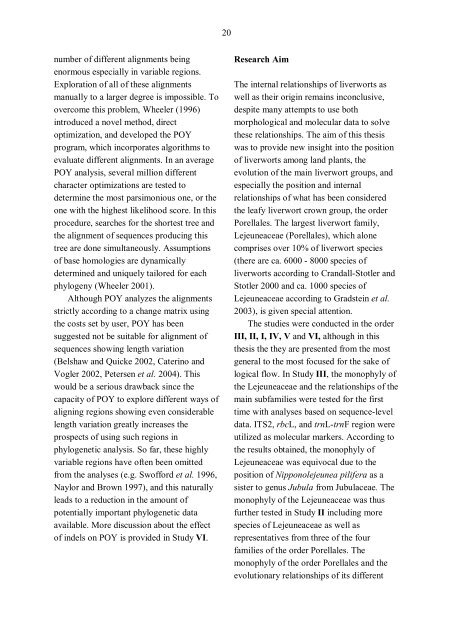Evolutionary relationships of liverworts with a special focus ... - Doria
Evolutionary relationships of liverworts with a special focus ... - Doria
Evolutionary relationships of liverworts with a special focus ... - Doria
Create successful ePaper yourself
Turn your PDF publications into a flip-book with our unique Google optimized e-Paper software.
20<br />
number <strong>of</strong> different alignments being<br />
enormous e<strong>special</strong>ly in variable regions.<br />
Exploration <strong>of</strong> all <strong>of</strong> these alignments<br />
manually to a larger degree is impossible. To<br />
overcome this problem, Wheeler (1996)<br />
introduced a novel method, direct<br />
optimization, and developed the POY<br />
program, which incorporates algorithms to<br />
evaluate different alignments. In an average<br />
POY analysis, several million different<br />
character optimizations are tested to<br />
determine the most parsimonious one, or the<br />
one <strong>with</strong> the highest likelihood score. In this<br />
procedure, searches for the shortest tree and<br />
the alignment <strong>of</strong> sequences producing this<br />
tree are done simultaneously. Assumptions<br />
<strong>of</strong> base homologies are dynamically<br />
determined and uniquely tailored for each<br />
phylogeny (Wheeler 2001).<br />
Although POY analyzes the alignments<br />
strictly according to a change matrix using<br />
the costs set by user, POY has been<br />
suggested not be suitable for alignment <strong>of</strong><br />
sequences showing length variation<br />
(Belshaw and Quicke 2002, Caterino and<br />
Vogler 2002, Petersen et al. 2004). This<br />
would be a serious drawback since the<br />
capacity <strong>of</strong> POY to explore different ways <strong>of</strong><br />
aligning regions showing even considerable<br />
length variation greatly increases the<br />
prospects <strong>of</strong> using such regions in<br />
phylogenetic analysis. So far, these highly<br />
variable regions have <strong>of</strong>ten been omitted<br />
from the analyses (e.g. Sw<strong>of</strong>ford et al. 1996,<br />
Naylor and Brown 1997), and this naturally<br />
leads to a reduction in the amount <strong>of</strong><br />
potentially important phylogenetic data<br />
available. More discussion about the effect<br />
<strong>of</strong> indels on POY is provided in Study VI.<br />
Research Aim<br />
The internal <strong>relationships</strong> <strong>of</strong> <strong>liverworts</strong> as<br />
well as their origin remains inconclusive,<br />
despite many attempts to use both<br />
morphological and molecular data to solve<br />
these <strong>relationships</strong>. The aim <strong>of</strong> this thesis<br />
was to provide new insight into the position<br />
<strong>of</strong> <strong>liverworts</strong> among land plants, the<br />
evolution <strong>of</strong> the main liverwort groups, and<br />
e<strong>special</strong>ly the position and internal<br />
<strong>relationships</strong> <strong>of</strong> what has been considered<br />
the leafy liverwort crown group, the order<br />
Porellales. The largest liverwort family,<br />
Lejeuneaceae (Porellales), which alone<br />
comprises over 10% <strong>of</strong> liverwort species<br />
(there are ca. 6000 - 8000 species <strong>of</strong><br />
<strong>liverworts</strong> according to Crandall-Stotler and<br />
Stotler 2000 and ca. 1000 species <strong>of</strong><br />
Lejeuneaceae according to Gradstein et al.<br />
2003), is given <strong>special</strong> attention.<br />
The studies were conducted in the order<br />
III, II, I, IV, V and VI, although in this<br />
thesis the they are presented from the most<br />
general to the most <strong>focus</strong>ed for the sake <strong>of</strong><br />
logical flow. In Study III, the monophyly <strong>of</strong><br />
the Lejeuneaceae and the <strong>relationships</strong> <strong>of</strong> the<br />
main subfamilies were tested for the first<br />
time <strong>with</strong> analyses based on sequence-level<br />
data. ITS2, rbcL, and trnL-trnF region were<br />
utilized as molecular markers. According to<br />
the results obtained, the monophyly <strong>of</strong><br />
Lejeuneaceae was equivocal due to the<br />
position <strong>of</strong> Nipponolejeunea pilifera as a<br />
sister to genus Jubula from Jubulaceae. The<br />
monophyly <strong>of</strong> the Lejeuneaceae was thus<br />
further tested in Study II including more<br />
species <strong>of</strong> Lejeuneaceae as well as<br />
representatives from three <strong>of</strong> the four<br />
families <strong>of</strong> the order Porellales. The<br />
monophyly <strong>of</strong> the order Porellales and the<br />
evolutionary <strong>relationships</strong> <strong>of</strong> its different
















